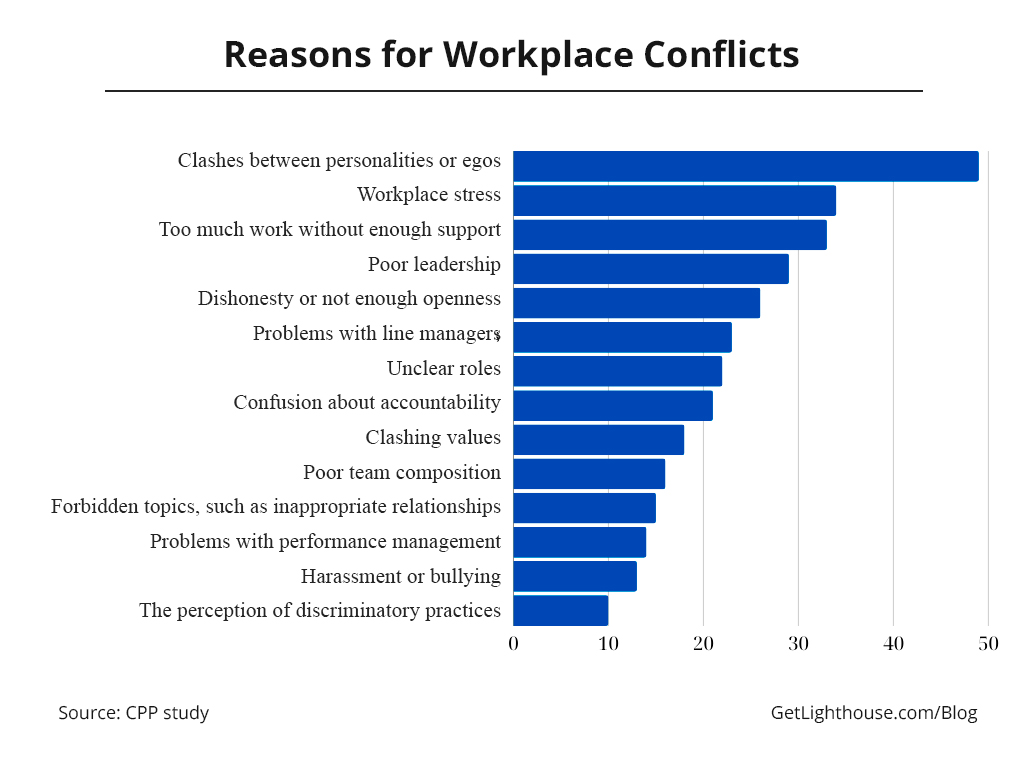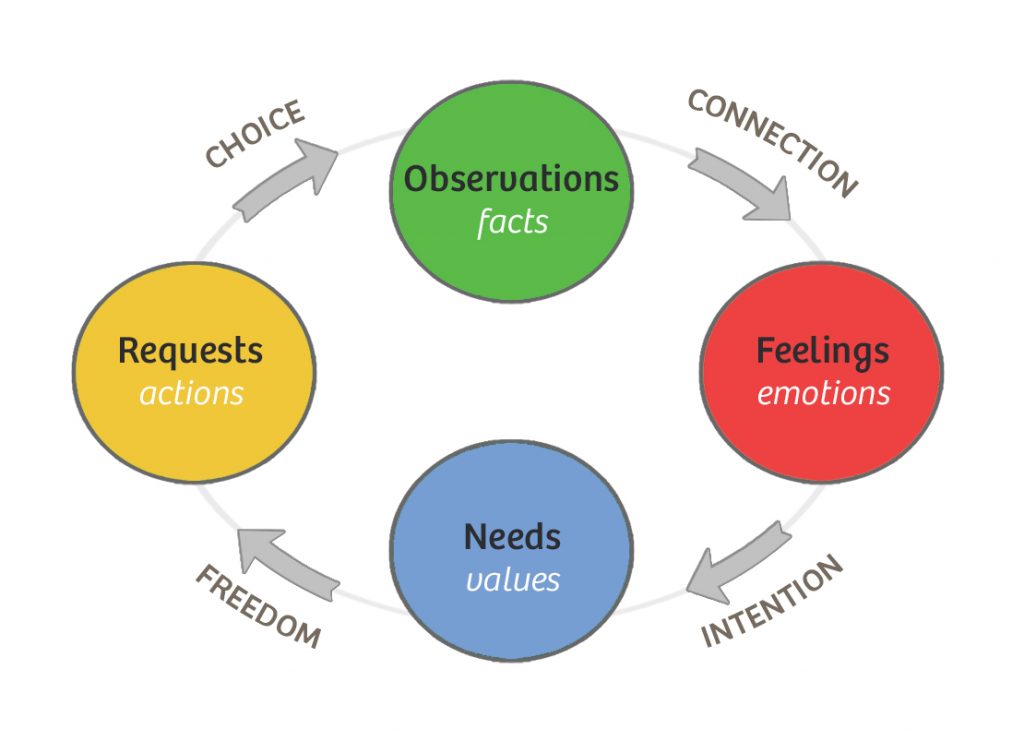“I can’t stand working with Joe. He’s impossible!”
“Those expectations are unreasonable. How can you expect me to do that?!”
“That’s a dumb idea. Why would we ever do that?”
These are the kinds of workplace conflicts that managers deal with regularly. How you choose to handle them can determine whether your team performs at a high level, or devolves into petty squabbles, low morale, and isolation.
No matter how hard you try, you can’t avoid conflicts at work. Everyone on your team has a different perspective on the world, life, and work, so don't be surprised that sometimes miscommunications happen, competition burns strongly, or tensions flare up.
But different points of view are just one of the reasons why workplace conflicts happen.
Understand the costs and causes of Workplace Conflicts
Understanding the root causes of workplace conflicts is essential for effective management.
CPP, Inc., conducted a study in partnership with OPP, Ltd. in Europe and Fellipelli in Brazil. Surveying 5,000 full-time employees across nine countries, the study sought to understand how different cultures perceive and react to conflict.
Their research identified common triggers of conflict, and examined their effects on both individuals and organizations. Here’s what they found were the biggest causes of conflicts at work:

As you can see, there are many potential causes, though a few (personalities/egos, stress, and workloads) stand out as the biggest contributors. They’re where you should start when trying to identify and fix an issue.
However, with so many different contributing forces, it also means that even if you do everything right, and don’t create any conflict yourself, there’s plenty of ways your team can have conflict anyways.
What’s a manager to do?!?
As a manager, you play a crucial role in handling conflict on your team. You often serve as a mediator, a conflict resolution specialist, and your example guides others in how they should act.
Yet, maybe you don’t feel like you have the best skills for handling conflict. Fortunately, we’ll be helping you with that today.
And the fact is, you can't afford to ignore resolving these workplace conflicts.
They’re all around you. According to CPP each employee in the US spends about 2.8 hours per week dealing with conflict. And that adds up fast; their calculations found that it costs approximately $359 billion in total lost time and productivity in a single year.
Fortunately, resolving these conflicts effectively will not only help you save money, but can also bring several positive changes. A study at Columbia University found that companies with a healthy corporate culture show, on average, a turnover rate of just 13.9% compared to 48.4% at companies with a poor culture.
And this is reinforced in the CPP study; when handled the right way, 76% of workers reported conflict led to positive results, such as improved approaches to problems, deeper insights about colleagues, and better innovation. Avoiding dealing with these conflicts would have prevented these positive outcomes.
Knowing that you can turn conflict into positive results, we’re teaching you 4 methods you can use to accomplish that, plus sharing some real life examples.
Table of Contents:
Methods for dealing with workplace conflicts:
- Avoid conflicts proactively
- Use nonviolent communication
- Listen actively
- Understand everyone's conflict styles
And bonus:
You can build a more positive and collaborative team culture with the right conflict resolution approaches, so let’s take a look at 4 great tactics you can use.
4 Proven Tactics for Managers to Resolve Workplace Conflicts
As a manager, there are many approaches you can use to resolve workplace conflicts. It’s important to know multiple techniques, because not all approaches are equally effective in all situations.
Today’s 4 tactics will give you a variety of tools you can use, and over time integrate them into your preferred set of approaches.
Use your best instincts (and a little trial and error) to find the best time to use them, and keep looking for additional ones; the more tactics you have the better equipped you will be no matter the situation.

Avoiding Conflicts Proactively
Being proactive isn't just about staying one step ahead; it's about creating a work environment where issues are so small that they're handled with a simple chat rather than major crises.
Think about it: proactive conflict resolution is like strategic project planning. You wouldn't jump into a new project without first laying out a clear plan, setting milestones, and identifying potential risks, would you?
This approach to workplace conflict is about preparing and planning to avoid problems before they arise. By setting clear team expectations from the start, holding regular one-on-one meetings to address concerns before they escalate, and soliciting team input on upcoming changes, you're effectively plotting a course for smoother sailing.
Here are some benefits of being proactive:
- Enhances Psychological Safety: When team members feel safe to express their concerns without fear of retribution, they're more likely to speak up early when something bothers them.
- Improves Communication: Clear, open lines of communication mean problems can be discussed and resolved long before they escalate.
- Resolves Issues Early: Small problems are easier to solve. Catching them early prevents the kind of conflicts that can derail projects and sour relationships.
So, how can you, as a manager, cultivate this proactive paradise? Here are a few actionable tips to get you started:
- Set team rules/norms collaboratively: When you set ground rules, listen to your team's questions, concerns, and ideas. This will not only ensure that everyone is on the same page, but also increases their commitment to them.
- Check-in regularly with each team member: These check-ins don't have to be long, but they should be regular and meaningful. It's your chance to catch up on any simmering issues and address them promptly.
- Give good notice before making impactful decisions: Surprises can lead to resistance. Giving your team a heads-up about changes allows them to adjust and voice any concerns with you early.
- Welcome ideas and input from the team: Create an environment where team members feel their suggestions are valued, and they can bring up issues without you asking first. This not only fosters innovation, but also helps you identify potential conflicts early on.
By using these strategies, you're not just avoiding conflicts; you're building a stronger, more cohesive team. Remember, a proactive approach to conflict resolution is like preventive medicine for your team's health.
Now, if you'd like to go deeper on how exactly to apply these tactics to your team, read these posts:
- How To Win An Argument At Work
- How To Get Buy In At Work: A Step By Step Guide
- 7 Essential Tips For Effective 1 On 1 Meetings With Your Manager

Nonviolent Communication
Handling conflicts in the workplace isn't about avoiding them; it's about resolving them in a way that strengthens relationships rather than damaging them.
Nonviolent Communication (NVC) is a powerful technique that accomplishes exactly that; it’s a method that helps you build more understanding, respect, and cooperation, even when two sides are having trouble communicating otherwise.
Developed by Marshall B. Rosenberg, NVC is more than a communication technique; it's a way of relating to others with compassion and empathy, focusing on understanding needs and making requests, rather than judging or demanding.
Fortunately, NVC isn’t some complex process that takes weeks of training. Instead, it involves 4 simple steps:
- 1) Observe Facts Without Evaluating: Start by describing the situation objectively, without any interpretation or judgment. This is about stating what you see or hear that is contributing to the discomfort or conflict.
- 2) Identify Your Feelings and Needs: Share your feelings about the situation, and identify the underlying needs or values that are not being met. This step requires you to be honest and vulnerable with your teammates, as you express your own emotions and recognize the needs behind them.
- 3) Make Specific Requests to Meet Your Needs: Clearly articulate what you require or desire in a positive and concrete manner. This involves requesting actions that can help fulfill your needs without assigning blame or criticism.
- 4) Express Empathy for the Other Side: Try to understand and reflect on the feelings and needs of the other person, even if you don't agree with them. Empathy is key in creating a connection and finding common ground.
Now, let’s take a look at how NVC could work in action, here is a simple dialogue example:
Manager: "I noticed that the report due yesterday hasn't been submitted yet (observation). I'm feeling concerned because meeting our deadlines is crucial for the project's timeline (feeling). I need to ensure we're on track to meet our project goals (need). Could you submit the report by the end of the day today (specific request)?"
Employee: "I understand your concern. I've been juggling a few urgent tasks and needed more time to complete the report (expressing their own needs and feelings). I can prioritize it and have it to you by this afternoon."
By using the NVC technique, you can more easily solve a lot of workplace conflicts with your teammates. It works so well, because it builds empathy, reduces defensiveness, and encourages to have an open dialog. Here’s how it accomplishes those things:
- Builds Empathy: By focusing on feelings and needs, NVC helps both sides understand each other's perspective, which creates a deeper connection.
- Avoids Provoking Defensiveness: When you express your needs and make requests without judgment or blame, NVC minimizes defensive reactions, which makes it easier to find a solution together.
- Creates Solutions: NVC encourages collaborative problem-solving, focusing on meeting the needs of all parties involved.
By integrating NVC into your management style, you're not just resolving conflicts; you're enhancing your team’s cohesion and building a more empathetic, understanding workplace culture. You also teach your team how to do the same through your example (or even better, if you then teach them the process, too).
If you're intrigued by the potential of NVC to transform your communication and conflict resolution strategies, we highly recommend reading Marshall B. Rosenberg's "Nonviolent Communication: A Language of Life." In his book, you will find information about the principles of NVC, and how you can apply it in a variety of situations at both work and in your personal life.

Active Listening
You, as a manager, have one of the most powerful tools at your disposal every day — active listening. It's the cornerstone of effective communication and a critical skill for conflict resolution.
Active listening is not just about hearing your team’s words; it's about fully comprehending the message they’re trying to get across, building a deep understanding of their perspective, and making them feel truly heard.
If you want to master active listening, then you need to develop these key skills:
- Listen without interrupting: This might seem basic, but it's fundamental. Give your teammate your full attention, and resist the impulse to interrupt or formulate your response while they're speaking.
- Reflect back on what you heard: This involves stating back to them in your own words what you think you heard. Your team member can then either correct anything you misstated or rest easy knowing you understand their perspective.
- Ask clarifying questions: If something isn't clear, ask open-ended questions that encourage your teammates to explain further. This shows you're engaged and seeking to understand them fully.
- Sum up the key points: Finally, offer a brief summary of the conversation to confirm that you've understood everything correctly. This step helps make sure you’re heading in the right direction and that you end your meeting in agreement on any next steps. Remember that the point of conflicts is resolution, not just understanding the problem.
Here is an example that shows active listening at work:
Employee: "I've been feeling overwhelmed with the current workload and deadlines."
Manager: "I understand your frustration. It sounds like you're under a lot of pressure and finding it challenging to manage the workload and deadlines. What specific tasks are causing you the most stress?"
Employee: "Mainly the X project and the Y report, because of reason Z."
Manager: "So, the X project and the Y report are particularly stressful. How can we adjust your workload or deadlines to help relieve some of this pressure?"
This example demonstrates active listening through acknowledgment, reflection, and seeking further information to understand better and address your employee's concerns. In reality, it would likely involve a few follow-up questions at each step, but the essence is shown through how the manager stays focused on what the employee says.
More than resolution
Active listening goes beyond simply helping you resolve conflicts; it has many benefits for you and your team:
- Validates Concerns: When your employees feel heard, it validates their feelings and concerns. This relieves stress and tension for you and them.
- Prevents Miscommunications: By ensuring you've fully understood their message, active listening helps prevent miscommunications that lead to you making the wrong conclusions and decisions.
- Builds Trust: Demonstrating that you value your team's input and take the time to listen to them builds trust, and creates a more open and honest workplace culture. Your team will then be more likely to come to you and open up in the future.
Active listening is not a passive activity, but an engaging process that strengthens relationships and improves your conflict resolution abilities. It's about creating a space where everyone feels heard, understood, and valued.
To delve deeper into how you can improve your listening skills and become a more effective listener, check our post on "How Managers Can Be More Effective Listeners".

Learn Your Team’s Conflict Styles
Understanding the diverse ways people approach conflict is like having a map of unfamiliar territory. It can guide you in navigating disagreements with insight and strategy.
The Thomas-Kilmann Conflict Model Instrument (TKI) serves exactly this purpose by outlining five distinct conflict styles: competing, accommodating, avoiding, collaborating, and compromising. Each style has its ideal time and place. Recognizing when to employ each can significantly improve your effectiveness as a manager.
Let’s dive deeper into the meaning of each of these styles:
- Competing: This style is assertive and uncooperative, a power-oriented approach where you pursue your own concerns at the other's expense. It's about 'winning' the conflict.
- Accommodating: The antithesis of competing, this style is cooperative, but unassertive. You might neglect your own concerns to satisfy those of others, essentially 'yielding' to their needs.
- Avoiding: Neither assertive, nor cooperative, this style involves sidestepping the conflict altogether. It can mean withdrawing from, or not addressing the conflict.
- Collaborating: Both assertive and cooperative, this style involves working with the other party to find a solution that fully satisfies the concerns of both. It's a 'win-win' scenario.
- Compromising: This style is moderately assertive and cooperative. It's about finding a middle ground, where each party makes concessions to resolve the conflict.
For starters, as a manager, it's crucial to reflect on your natural conflict style: Do you tend to stand your ground, prioritize harmony, sidestep tension, seek collaborative solutions, or aim for quick compromises?
Recognizing your tendencies is the first step toward expanding your conflict resolution techniques.
Know when to use each approach
To fully utilize TKI, you need to learn to adapt your approaches to the situation you are in. Here’s a couple of examples of how different styles can be effectively applied:
Collaborating Style for Complex Conflicts:
When a conflict involves complex issues with mutual goals, the collaborating style is ideal. It allows for creative problem-solving and ensures all parties' needs are met.
For instance, if two departments are clashing over a shared resource, working together to develop a new strategy that benefits both sides can lead to a more productive outcome than competing directly.
Compromising Style for Disputes Over Resources:
In situations where a quick, expedient solution is needed, and the conflict revolves around limited resources or minor disagreements, a compromising style can be effective. This approach acknowledges that while not everyone will get everything they want, all parties can leave feeling they've gained something.
For example, two departments have different views on the direction of a project. Instead of focusing on the divisions, they can engage in a series of collaborative meetings designed to understand each department's vision and constraints fully. Through these discussions, a new, unified strategy can emerge that aligns with the company's broader goals, ensuring that both departments contribute to a solution that is innovative and mutually beneficial.
—
By understanding the various conflict styles, you can consciously choose the right one to resolve each situation you and your team face. Then, by encouraging your team members to do the same can lead to a more adaptable, resilient, and cooperative workplace environment.
Understanding and applying the Thomas-Kilmann conflict styles model is a valuable addition to how you manage and resolve conflicts. By assessing your natural tendencies and learning to adapt your approach to suit different scenarios, you become a more effective, empathetic, and strategic leader.
To learn more about TKI and how to apply it at work, read more here.
Real Examples of Handling Workplace Conflicts
The best way to understand a new concept is often to see an example in action. Now that we’ve taught you the basics of each of these approaches, let’s see how 2 of them worked in real situations.
Story #1: NVC bridges communication styles
These tactics can work on managers just as much as team members. I saw firsthand how Nonviolent Communication can get through when nothing else seems to work.
I had a manager once who I struggled greatly communicating with. He had a laid back, California attitude, while I had a direct, sometimes brash, East Coast style. When I came to him with issues, my direct style caused him to shut down, while his indirect, casual style made me miss every hint he dropped.
One of many tasks I had was to help provide data for a presentation he needed to give. It was really frustrating to me that I’d spend a large portion of my day on it and hear nothing back from him after sending them to him.
Since nothing else seemed to work, I gave Nonviolent Communication a try. I messaged them:
“I feel frustrated when I send you data and get no acknowledgment or feedback from you. A thumbs up and occasional “this is good” would help me know you received it and it is what you need, or what I need to improve, add, or change.”
To my surprise, simply stating the issue using the NVC framework got a very positive response from them. Going forward he always “Thumbs up’d” receipt of important messages in Slack, and if he liked what he saw, I got a “This good”, or he told me what he needed instead.
Story #2: Using Active Listening to Relieve Concerns
A friend of mine was working as a manager of a content marketing team. Her CEO decided to transfer one employee from the sales department to her team. This new member was known for their ability to find new partners, but she was about to face a significant change in how her work was tracked and evaluated.
In my friend's department, everyone logged their tasks, time, and notes in a shared Google spreadsheet. When she explained this to the new team member, they freaked out. Instead of pulling rank or dismissing their reaction, she suggested they chat one-on-one, so they'd feel comfortable opening up.
Crucially, in that meeting she practiced active listening, so that she could truly understand what they had to say and make them feel heard.
During their talk, she asked open-ended questions for a better understanding of the situation, asking questions like. "What concerns do you have about logging your tasks and time?" and "How do you feel about your recent change in role?"
By being genuinely curious and interested in their answers, she learned about their concerns and some previously unknown other issues they were dealing with.
Feeling heard and understood, they became more receptive to their change in role, and the new process of logging all of their time. Together, they created a plan to smooth the team member’s transition, and address their other concerns.
This empathetic approach completely changed their perspective. They realized the spreadsheet wasn't just about accountability, but about making the team more effective and understanding costs and investments by everyone.
Final word: Workplace conflict is unavoidable. How you handle it makes all the difference.
As we've explored today, you can’t avoid workplace conflicts; sooner or later conflicts will find you no matter what you do. However, the good news is that you now have learned 4 battle-tested techniques to resolve conflicts on your team.
As a manager, you play a crucial role in maintaining a good company culture and the morale on your team. Learning to master these approaches (and others) will help you grow your abilities to resolve conflicts before they cause long term problems.
If you and your fellow managers want to develop more crucial leadership skills like resolving workplace conflict, consider investing in Lighthouse Lessons training. Our 8+ courses are all purpose built for busy managers like you, while helping strengthen bonds between your leaders. You can learn more and sign up for a future course here.





